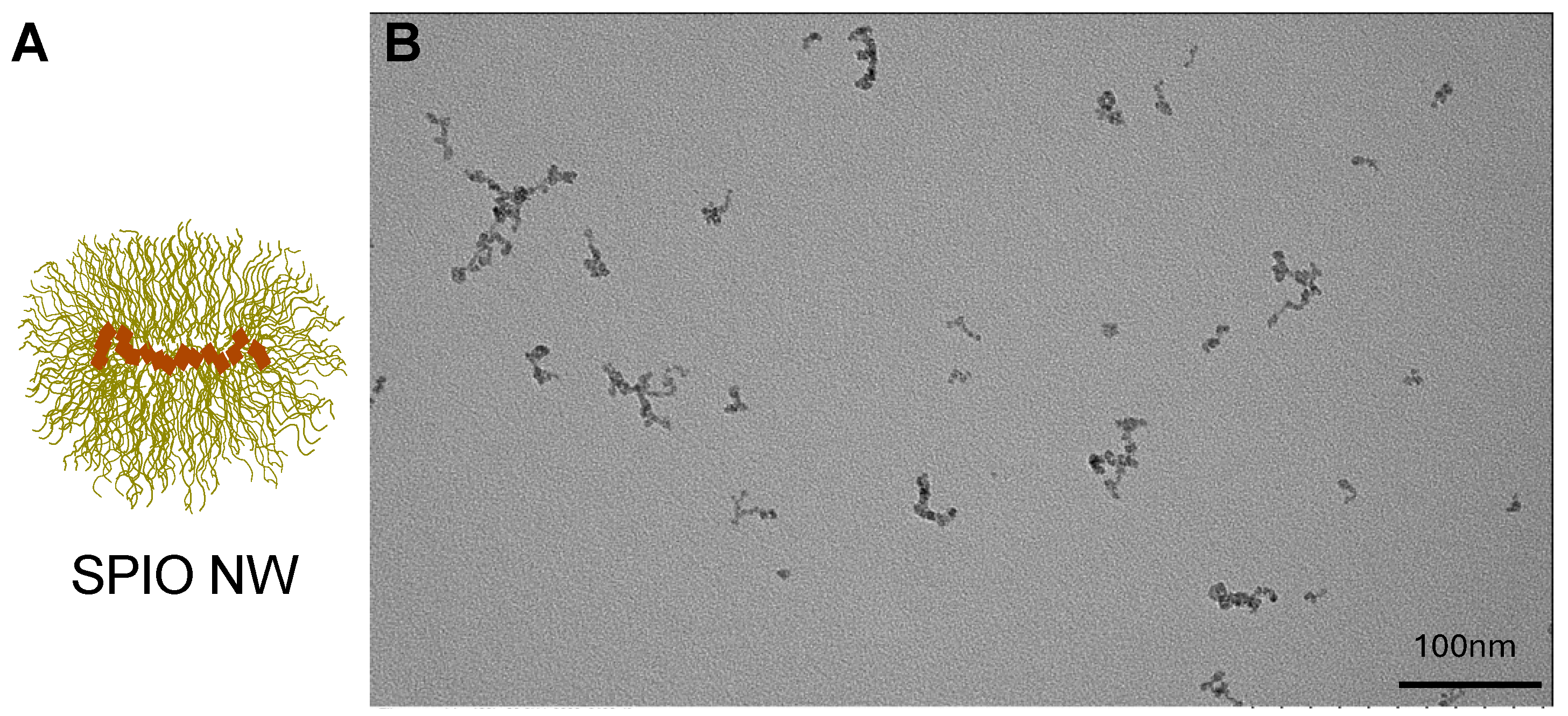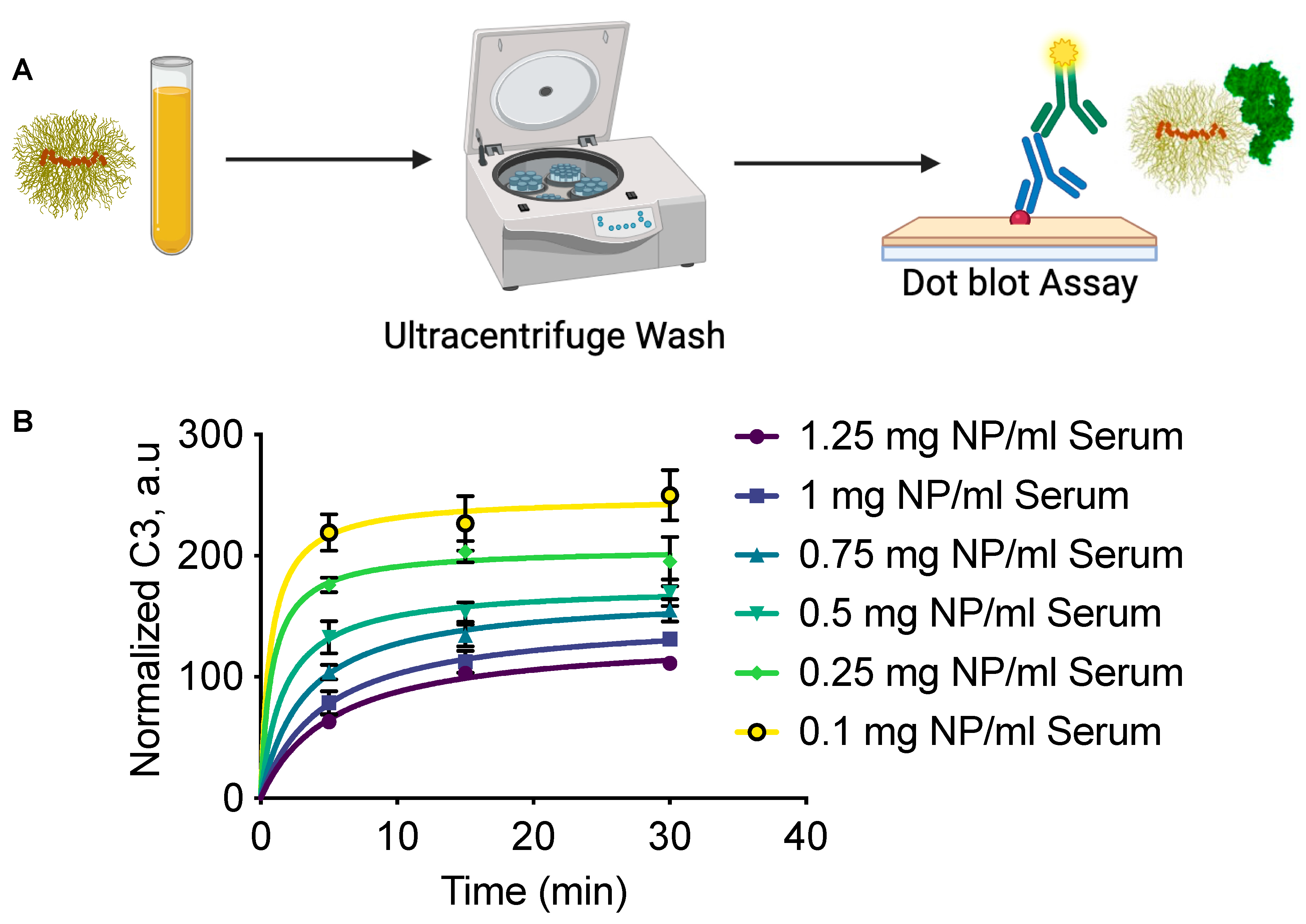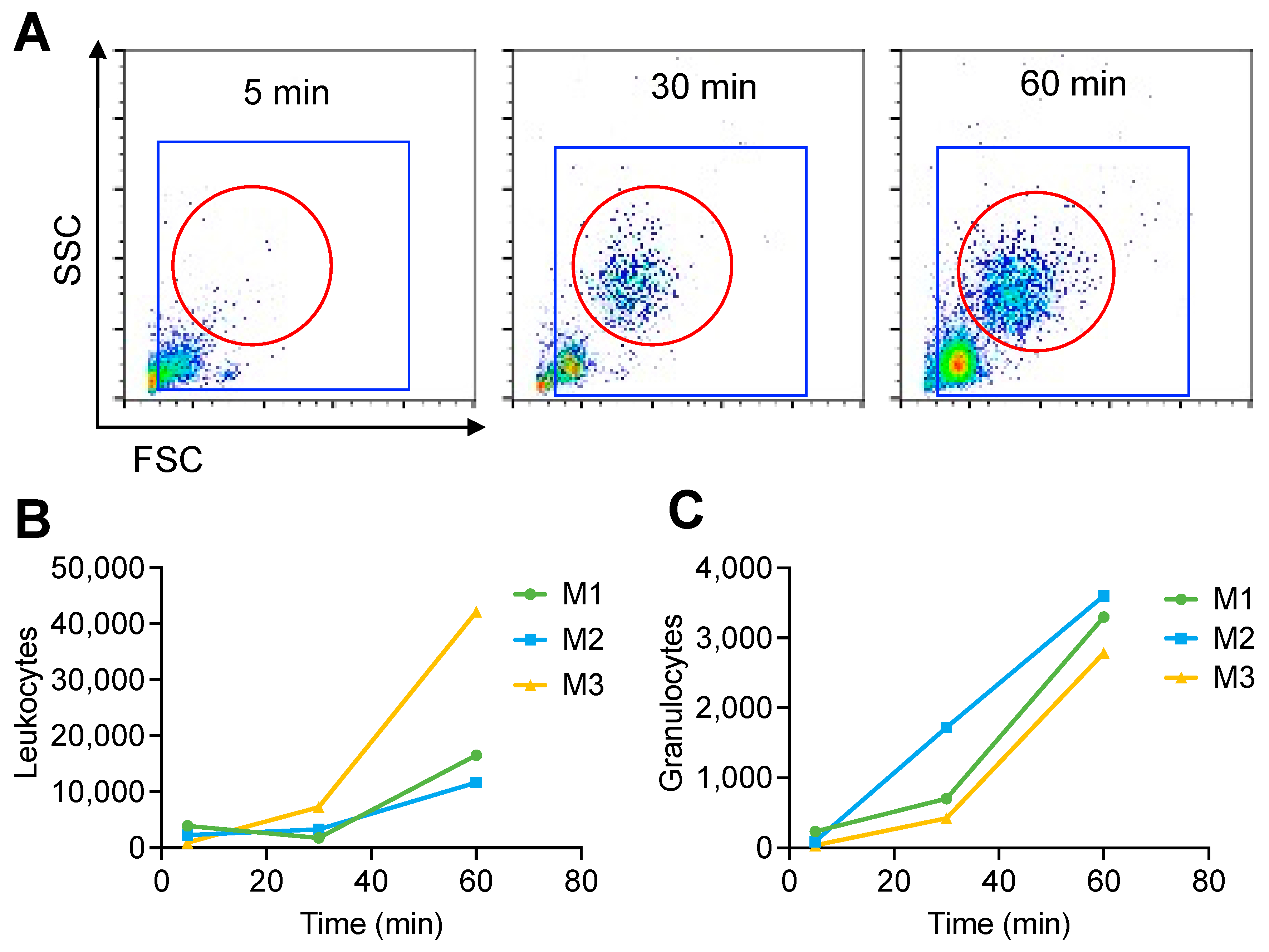Different Kinetics of Complement Opsonization, Immune Uptake, and IL-6 Cytokine Response After Bolus Injection of Superparamagnetic Iron Oxide Nanoworms in Mice
Abstract
1. Introduction
2. Materials and Methods
2.1. Synthesis and Characterization of SPIO NWs
2.2. C3 Dot Blot Assay
2.3. In Vivo Administration and Sample Collection
2.4. Cytokine Analysis in Mouse Plasma
3. Results
4. Discussion
Author Contributions
Funding
Institutional Review Board Statement
Data Availability Statement
Acknowledgments
Conflicts of Interest
References
- Boehm, H. Acidic and Basic Properties of Hydroxylated Metal Oxide Surfaces. Discuss. Faraday Soc. 1971, 52, 264–275. [Google Scholar] [CrossRef]
- Bautista, M.C.; Bomati-Miguel, O.; Morales, M.D.; Serna, C.J.; Veintemillas-Verdaguer, S. Surface Characterisation of Dextran-Coated Iron Oxide Nanoparticles Prepared by Laser Pyrolysis and Coprecipitation. J. Magn. Magn. Mater. 2005, 293, 20–27. [Google Scholar] [CrossRef]
- Jung, C.W. Surface Properties of Superparamagnetic Iron Oxide Mr Contrast Agents: Ferumoxides, Ferumoxtran, Ferumoxsil. Magn. Reason. Imaging 1995, 13, 675–691. [Google Scholar] [CrossRef]
- Molday, R.S.; MacKenzie, D. Immunospecific Ferromagnetic Iron-Dextran Reagents for the Labeling and Magnetic Separation of Cells. J. Immunol. Methods 1982, 52, 353–367. [Google Scholar] [CrossRef]
- Park, J.H.; Gu, L.; von Maltzahn, G.; Ruoslahti, E.; Bhatia, S.N.; Sailor, M.J. Biodegradable Luminescent Porous Silicon Nanoparticles for in Vivo Applications. Nat. Mater. 2009, 8, 331–336. [Google Scholar] [CrossRef]
- Simberg, D.; Park, J.H.; Karmali, P.P.; Zhang, W.M.; Merkulov, S.; McCrae, K.; Bhatia, S.N.; Sailor, M.; Ruoslahti, E. Differential Proteomics Analysis of the Surface Heterogeneity of Dextran Iron Oxide Nanoparticles and the Implications for Their in Vivo Clearance. Biomaterials 2009, 30, 3926–3933. [Google Scholar] [CrossRef] [PubMed]
- Seo, W.S.; Lee, J.H.; Sun, X.M.; Suzuki, Y.; Mann, D.; Liu, Z.; Terashima, M.; Yang, P.C.; McConnell, M.V.; Nishimura, D.G.; et al. Feco/Graphitic-Shell Nanocrystals as Advanced Magnetic-Resonance-Imaging and near-Infrared Agents. Nat. Mater. 2006, 5, 971–976. [Google Scholar] [CrossRef]
- LaConte, L.E.; Nitin, N.; Zurkiya, O.; Caruntu, D.; O’Connor, C.J.; Hu, X.; Bao, G. Coating Thickness of Magnetic Iron Oxide Nanoparticles Affects R2 Relaxivity. J. Magn. Reason. Imaging 2007, 26, 1634–1641. [Google Scholar] [CrossRef]
- Tong, S.; Hou, S.J.; Zheng, Z.L.; Zhou, J.; Bao, G. Coating Optimization of Superparamagnetic Iron Oxide Nanoparticles for High T-2 Relaxivity. Nano Lett. 2010, 10, 4607–4613. [Google Scholar] [CrossRef]
- Choo, E.S.G.; Tang, X.S.; Sheng, Y.; Shuter, B.; Xue, J.M. Controlled Loading of Superparamagnetic Nanoparticles in Fluorescent Nanogels as Effective T-2-Weighted Mri Contrast Agents. J. Mater. Chem. 2011, 21, 2310–2319. [Google Scholar] [CrossRef]
- Yoon, T.J.; Lee, H.; Shao, H.; Hilderbrand, S.A.; Weissleder, R. Multicore Assemblies Potentiate Magnetic Properties of Biomagnetic Nanoparticles. Adv. Mater. 2011, 23, 4793–4797. [Google Scholar] [CrossRef] [PubMed]
- Lee, N.; Choi, Y.; Lee, Y.; Park, M.; Moon, W.K.; Choi, S.H.; Hyeon, T. Water-Dispersible Ferrimagnetic Iron Oxide Nanocubes with Extremely High R(2) Relaxivity for Highly Sensitive In Vivo Mri of Tumors. Nano Lett. 2012, 12, 3127–3131. [Google Scholar] [CrossRef] [PubMed]
- Poselt, E.; Kloust, H.; Tromsdorf, U.; Janschel, M.; Hahn, C.; Masslo, C.; Weller, H. Relaxivity Optimization of a Pegylated Iron-Oxide-Based Negative Magnetic Resonance Contrast Agent for T(2)-Weighted Spin-Echo Imaging. ACS Nano 2012, 6, 1619–1624. [Google Scholar] [CrossRef]
- Raynal, I.; Prigent, P.; Peyramaure, S.; Najid, A.; Rebuzzi, C.; Corot, C. Macrophage Endocytosis of Superparamagnetic Iron Oxide Nanoparticles: Mechanisms and Comparison of Ferumoxides and Ferumoxtran-10. Investig. Radiol. 2004, 39, 56–63. [Google Scholar] [CrossRef] [PubMed]
- Bulte, J.W.; Kraitchman, D.L. Iron Oxide Mr Contrast Agents for Molecular and Cellular Imaging. NMR Biomed. 2004, 17, 484–499. [Google Scholar] [CrossRef]
- Moore, A.; Weissleder, R.; Bogdanov, A., Jr. Uptake of Dextran-Coated Monocrystalline Iron Oxides in Tumor Cells and Macrophages. J. Magn. Reason. Imaging 1997, 7, 1140–1145. [Google Scholar] [CrossRef]
- Rampton, D.; Folkersen, J.; Fishbane, S.; Hedenus, M.; Howaldt, S.; Locatelli, F.; Patni, S.; Szebeni, J.; Weiss, G. Hypersensitivity Reactions to Intravenous Iron: Guidance for Risk Minimization and Management. Haematologica 2014, 99, 1671–1676. [Google Scholar] [CrossRef]
- Fulop, T.; Nemes, R.; Meszaros, T.; Urbanics, R.; Kok, R.J.; Jackman, J.A.; Cho, N.J.; Storm, G.; Szebeni, J. Complement Activation In Vitro and Reactogenicity of Low-Molecular Weight Dextran-Coated Spions in the Pig Carpa Model: Correlation with Physicochemical Features and Clinical Information. J. Control Release 2018, 270, 268–274. [Google Scholar] [CrossRef]
- Gerogianni, A.; Bal, M.; Mohlin, C.; Woodruff, T.M.; Lambris, J.D.; Mollnes, T.E.; Sjostrom, D.J.; Nilsson, P.H. In Vitro Evaluation of Iron Oxide Nanoparticle-Induced Thromboinflammatory Response Using a Combined Human Whole Blood and Endothelial Cell Model. Front. Immunol. 2023, 14, 1101387. [Google Scholar] [CrossRef]
- Benasutti, H.; Wang, G.; Vu, V.P.; Scheinman, R.; Groman, E.; Saba, L.; Simberg, D. Variability of Complement Response toward Preclinical and Clinical Nanocarriers in the General Population. Bioconjug. Chem. 2017, 28, 2747–2755. [Google Scholar] [CrossRef]
- Li, Y.; Monte, A.; Dylla, L.; Moghimi, S.M.; Simberg, D. Validation of Dot Blot Immunoassay for Measurement of Complement Opsonization of Nanoparticles. J. Immunol. Methods 2024, 528, 113668. [Google Scholar] [CrossRef] [PubMed]
- Li, Y.; Jacques, S.; Gaikwad, H.; Wang, G.; Banda, N.K.; Holers, V.M.; Scheinman, R.I.; Tomlinson, S.; Moghimi, S.M.; Simberg, D. Inhibition of Acute Complement Responses Towards Bolus-Injected Nanoparticles Using Targeted Short-Circulating Regulatory Proteins. Nat. Nanotechnol. 2024, 19, 246–254. [Google Scholar] [CrossRef]
- Wolf-Grosse, S.; Rokstad, A.M.; Ali, S.; Lambris, J.D.; Mollnes, T.E.; Nilsen, A.M.; Stenvik, J. Iron Oxide Nanoparticles Induce Cytokine Secretion in a Complement-Dependent Manner in a Human Whole Blood Model. Int. J. Nanomed. 2017, 12, 3927–3940. [Google Scholar] [CrossRef]
- Li, Y.; Wu, W.; Liu, Q.; Wu, Q.; Ren, P.; Xi, X.; Liu, H.; Zhao, J.; Zhang, W.; Wang, Z.; et al. Specific Surface-Modified Iron Oxide Nanoparticles Trigger Complement-Dependent Innate and Adaptive Antileukaemia Immunity. Nat. Commun. 2024, 15, 10400. [Google Scholar] [CrossRef]
- Chen, C.; Li, Y.; Zhou, D.; Fan, J.; Hu, X.; Zhang, R.; Ge, J.; Cao, X.; Qi, H.; Wang, N.; et al. Splenic Response to Protein Corona of Nanoparticles in Vivo. Nano Today 2025, 62, 102676. [Google Scholar] [CrossRef]
- Chen, F.; Wang, G.; Griffin, J.I.; Brenneman, B.; Banda, N.K.; Holers, V.M.; Backos, D.S.; Wu, L.; Moghimi, S.M.; Simberg, D. Complement Proteins Bind to Nanoparticle Protein Corona and Undergo Dynamic Exchange In Vivo. Nat. Nanotechnol. 2017, 12, 387–393. [Google Scholar] [CrossRef]
- Chen, G.Y.; Nuñez, G. Sterile Inflammation: Sensing and Reacting to Damage. Nat. Rev. Immunol. 2010, 10, 826–837. [Google Scholar] [CrossRef]





Disclaimer/Publisher’s Note: The statements, opinions and data contained in all publications are solely those of the individual author(s) and contributor(s) and not of MDPI and/or the editor(s). MDPI and/or the editor(s) disclaim responsibility for any injury to people or property resulting from any ideas, methods, instructions or products referred to in the content. |
© 2025 by the authors. Licensee MDPI, Basel, Switzerland. This article is an open access article distributed under the terms and conditions of the Creative Commons Attribution (CC BY) license (https://creativecommons.org/licenses/by/4.0/).
Share and Cite
Li, Y.; Simberg, D. Different Kinetics of Complement Opsonization, Immune Uptake, and IL-6 Cytokine Response After Bolus Injection of Superparamagnetic Iron Oxide Nanoworms in Mice. J. Nanotheranostics 2025, 6, 16. https://doi.org/10.3390/jnt6030016
Li Y, Simberg D. Different Kinetics of Complement Opsonization, Immune Uptake, and IL-6 Cytokine Response After Bolus Injection of Superparamagnetic Iron Oxide Nanoworms in Mice. Journal of Nanotheranostics. 2025; 6(3):16. https://doi.org/10.3390/jnt6030016
Chicago/Turabian StyleLi, Yue, and Dmitri Simberg. 2025. "Different Kinetics of Complement Opsonization, Immune Uptake, and IL-6 Cytokine Response After Bolus Injection of Superparamagnetic Iron Oxide Nanoworms in Mice" Journal of Nanotheranostics 6, no. 3: 16. https://doi.org/10.3390/jnt6030016
APA StyleLi, Y., & Simberg, D. (2025). Different Kinetics of Complement Opsonization, Immune Uptake, and IL-6 Cytokine Response After Bolus Injection of Superparamagnetic Iron Oxide Nanoworms in Mice. Journal of Nanotheranostics, 6(3), 16. https://doi.org/10.3390/jnt6030016






